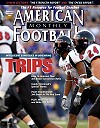AMERICAN FOOTBALL MONTHLY THE #1 RESOURCE FOR FOOTBALL COACHES
Article CategoriesAFM Magazine
|
The Drills Report: Defensive Line Progression and Drills: UW-Plattevilleby: Wayne Anderson© More from this issue At UWP, seven areas are emphasized that will make a defensive lineman successful on Saturdays. These areas are: Stance, Starts, Hands, Blow Delivery, Block Recognition, Squeeze and Escape, and Pass Rush Techniques. We feel that these are the areas that must be repped each day at practice. The first area that we work on is stance. Feet should be armpit width apart with toe to instep relationship. We want the toe to in-step relationship so that our defensive lineman can react in all three directions; we believe that if you have a toe to heel relationship this prevents us from moving smoothly in all three directions. The ball hand is down and the ball foot is back in a toe to instep relationship with your other foot. Sixty percent of the weight should be on it....The full article can only be seen by subscribers. Subscribe today!
|
|
|||||||
| HOME |
MAGAZINE |
SUBSCRIBE | ONLINE COLUMNISTS | COACHING VIDEOS |
Copyright 2025, AmericanFootballMonthly.com
All Rights Reserved





